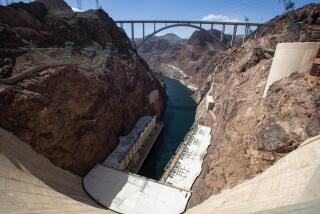San Clemente Delays Action on Tough Water-Rationing Law
- Share via
Because recent water shortages have all but evaporated, the San Clemente City Council on Wednesday put off considering a proposed emergency-only water-rationing law that experts say would be the toughest in the state.
The delay was prompted by Mayor Brian J. Rice, who said residents had already responded well to voluntary-conservation calls that went out during a water shortage earlier this summer.
Rice said that passing a water-rationing ordinance now, when an emergency no longer exists, would be “a slap in the face to residents.”
“It would be telling them ‘Thanks a lot, but your efforts were worthless,’ ” Rice concluded. The mayor said the voluntary cooperation of residents and businesses in the city had successfully averted a water crisis in recent weeks.
The city urged residents, builders and businesses to cut back water use after the reservoir supplying San Clemente dropped to unexpectedly low levels in July and the first two weeks in August. In the past two weeks, however, water supplies have been building up to about normal.
Water officials have said the shortage came about because consumers were using more water each day than the single supply pipe could pump back into the Tri-Cities Municipal Water District reservoir in San Clemente. Wholesale water has always been available for the reservoir, officials have said, but keeping the reservoir filled was a recurring problem.
The proposed emergency rationing law was drafted in case more water shortfalls come to San Clemente before 1991, when a second intake water pipe for the reservoir is scheduled to be completed.
The proposed law, if ever adopted, would be the first of its kind in the state, according to Jay Malinowski, a spokesman for the Los Angeles-based Metropolitan Water District. Malinowski said San Clemente’s proposal was unique because it clearly set water-level stages at which the law would be invoked and provided for fines of up to $100 for consumers not obeying cutbacks.
“There are a number of cities in Southern California with water conservation ordinances on the books, but none that I know of has anything like the one in San Clemente,” Malinowski said. “San Clemente’s ordinance calls for specific numbers (triggering conservation measures) and actual fines.”
The proposed rationing ordinance before the City Council on Wednesday would have required mandatory cutbacks--in an emergency--only on developers, businesses and commercial users. “It doesn’t impact the homeowner,” said Greg Morehead, the city’s utilities manager.
Rice said, however, that he worried that homeowners might not understand the ordinance and think it was aimed at them.
The council’s 5-0 decision to delay action technically delays consideration of the law for two weeks. Council members said they may decide to keep the proposal on the back burner even longer. But Rice said it could be resurrected for quick action “at any time, on 24 hours’ notice.”
San Clemente’s water comes from an independent public agency, the Tri-Cities Municipal Water District. The district, in turn, gets its water from the vast supplies kept by the Metropolitan Water District, the biggest water provider in Southern California. The MWD serves 14.7 million people from Santa Barbara to San Diego.
The Tri-Cities reservoir, situated on Calle Agua in northwest San Clemente, normally holds 48 million gallons. Ray Woodside, general manager of Tri-Cities, said the reservoir dipped to 17.3 million gallons on Aug. 18. The reservoir has been gradually refilling since then, he said.
“The water situation today is that we have 30,200,000 gallons in the reservoir,” Woodside said Wednesday. “So the water situation is not critical right now, but if warm Santa Ana winds start blowing in September, we could be in trouble again. September can be an awful bad month.” Santa Ana winds dry out the landscape, and residents respond by increasing the watering of lawns and plants, he noted.
Tri-Cities and San Clemente issued two conservation alerts during the recent water-shortage scare, Woodside said. Both were mainly aimed at developers and commercial firms. The first voluntary cutback asked for a 25% reduction in construction use of water and a 10% decrease in water used by commercial firms doing landscaping. The second conservation alert asked for a voluntary 50% reduction in water use in construction and a 20% reduction in industrial, recreation and landscaping use.
Rice went on cable television to urge water conservation by everyone, including homeowners.
More to Read
Sign up for Essential California
The most important California stories and recommendations in your inbox every morning.
You may occasionally receive promotional content from the Los Angeles Times.













